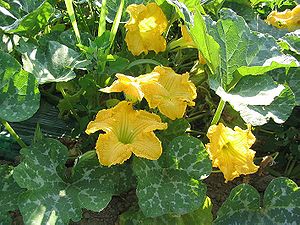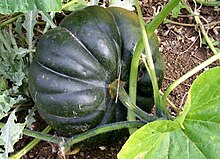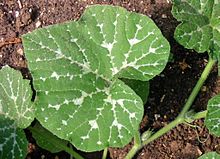Musk gourd
| Musk gourd | ||||||||||||
|---|---|---|---|---|---|---|---|---|---|---|---|---|

Musk gourd ( Cucurbita moschata ) |
||||||||||||
| Systematics | ||||||||||||
|
||||||||||||
| Scientific name | ||||||||||||
| Cucurbita moschata | ||||||||||||
| ( Duchesne ex Lam. ) Duchesne ex Poir. |
The musk gourd ( Cucurbita moschata ) is a cultivated species of the cucurbit family (Cucurbitaceae), which is native to America, but is now grown worldwide in warm regions. A subgroup of the musk gourd is the butternut gourd (also butternut gourd ).
features
The Butternut Squash is an annual , herbaceous plant that grows crawling or climbing, reaching a length of up to 6 meters. The whole plant is lightly to densely hairy. The shoot axes are slightly angular. The leaf stalks can reach a length of 30 cm and more. The leaf blade is (20 to 25) x (25 to 30) cm in size, broadly oval-heart-shaped to almost circular and spotted with white. It is slightly lobed with three to five oval to triangular lobes. The leaf margin is serrated.
blossoms
The musk gourd is single sexed ( monoecious ). The flowers are individually in leaf axils. The male flowers have a 16 to 18 cm long peduncle. The crown is 5 - 13.5 cm long, the corolla lobes take up to a third of the crown length.
The female flowers have a thick, 3 to 8 cm long flower stalk. The ovary is spherical, ovoid, cylindrical, pear or cone-shaped. The chalice is very small. Her stylus has three lobed scars .
fruit
The fruits are in form and color very variable armored berries , the mold usually corresponds to the ovary. The surface is smooth or ribbed, rarely warty or grainy. The color is light to dark green, solid green or with cream-colored spots or completely white. The bark is thick, soft and durable. The flesh is light to strong orange to greenish. The taste is light to very sweet, the meat is soft and generally not fibrous. The numerous seeds are oval to elliptical, (8 to 21) x (5 to 11) mm in size and have a yellowish-white surface.
Chromosome number
The number of chromosomes is 2n = 40.
Differentiation from other pumpkins
The musk pumpkin can be distinguished from other cultivated pumpkins in that the fruit stalk is hard, has round edges and widens strongly at the fruit base. The stem axis is grooved hard and smooth. The leaves are almost round to slightly lobed and soft. The seeds are white to brown, the surface smooth to slightly rough, the edge is clearly mostly jagged and darker.
distribution
The species is only known in culture, wild or stem forms are unknown. The musk gourd was grown in pre-Columbian times in Central and South America and in the southeastern United States, after which it was introduced in most of the tropical countries.
Systematics
The North American varieties are divided into three groups:
- Cheese: Their fruit is variable, but mostly flattened and with a yellow-brown rind.
- Crookneck: The fruit is rounded at the flower end and has a long, straight or curved neck.
- Bell: The fruit is bell-shaped to almost cylindrical.
This grouping cannot be used for the varieties in tropical America and Asia. Colombian land races often have small fruits with dark seeds. Japanese varieties, such as 'Chirimen' and 'Kikuza', often have warty and furrowed fruits.
A commonly grown variety is 'butternut', which is used as a winter squash. An old variety, especially popular in the USA in the 19th century, is 'Cheese', which was particularly valued for canning and as fodder.
Cultivation
The musk gourd is mainly grown in low areas with a hot, humid climate and is the most common type of gourd grown in the tropics. In Oaxaca , Mexico, however, some varieties are also grown at over 2200 m above sea level. Traditionally, they are often grown together with corn, beans and other pumpkins. Other cultivation methods are in vegetable gardens. The musk pumpkin is also grown on its own in intensive agriculture.
Sowing takes place at the beginning of the rainy season, development takes five to seven months. Some varieties, especially on the Yucatan , only take three to four months. In Oaxaca, it is also grown during the cool, dry season.
The musk gourd is grown widely in India, including in the arid Punjab. There are a large number of land races here. Breeding efforts are particularly directed towards early ripeness, high carotene content and a high ratio of female flowers to male flowers.
use
In its original area, the flowers, young shoots, young and ripe fruits are used as vegetables. Ripe fruits are also often made into sweets or used as animal feed. The seeds are eaten whole roasted or ground in stews. They are high in oil and protein.
history
The musk gourd was domesticated in Latin America, the exact area is unknown. Central America and Colombia will be discussed . There are native names for the pumpkin in both areas, which speaks in favor of independent domestication. The oldest archaeological finds come from northeast Mexico (caves of Ocampo , Tamaulipas ) and date from 4900 to 3500 BC. Further finds come from Tikal (2000 before to 850 after Chr.) And from Huaca Prieta , Peru (3000 BC). The musk pumpkin was already widespread in pre-Columbian times, with an old landrace called 'Seminole Pumpkin' in Florida from this time. In the 19th century, cultivation in India, Java , Angola and Japan is documented.
literature
- R. Lira Saade, S. Montes Hernández: Cucurbits . In: JE Hernández Bermejo, J. León (Ed.): Neglected crops. 1492 from a different perspective . FAO Plant Production and Protection Series No. 26, Rome 1994, pp. 63-77. ISBN 92-5-103217-3 (online1) (online2)
- RW Robinson, DS Decker-Walters: Cucurbits . CAB International, Wallingford 1997, pp. 71-83. ISBN 0-85199-133-5 (systematics)
Individual evidence
- ↑ Cucurbita moschata at Tropicos.org. In: IPCN Chromosome Reports . Missouri Botanical Garden, St. Louis
- ^ RW Robinson, DS Decker-Walters: Cucurbits . CAB International, Wallingford 1997, p. 75. ISBN 0-85199-133-5
- ^ NM Nayar, Rajendra Singh: Taxonomy, distribution and ethnobotanical uses . In: NM Nayar, TA More: Cucurbits . Science Publishers, Enfield 1998, pp. 1-18. ISBN 1-57808-003-7
- ^ BR Sharma, Tarsem Lal: Improvement and Cultivation of Cucurbita and Benincasa . In: NM Nayar, TA More: Cucurbits . Science Publishers, Enfield 1998, pp. 155-165. ISBN 1-57808-003-7


